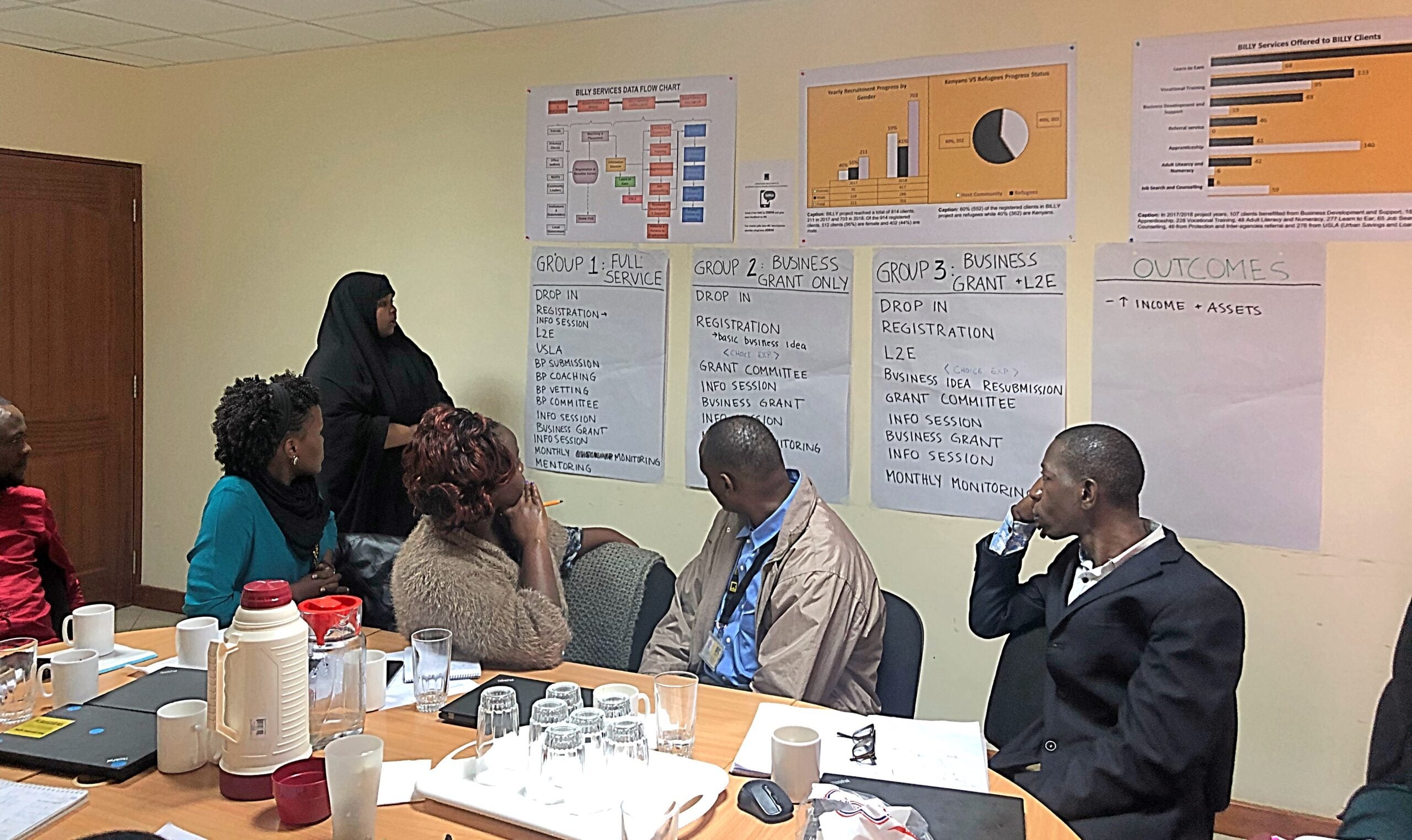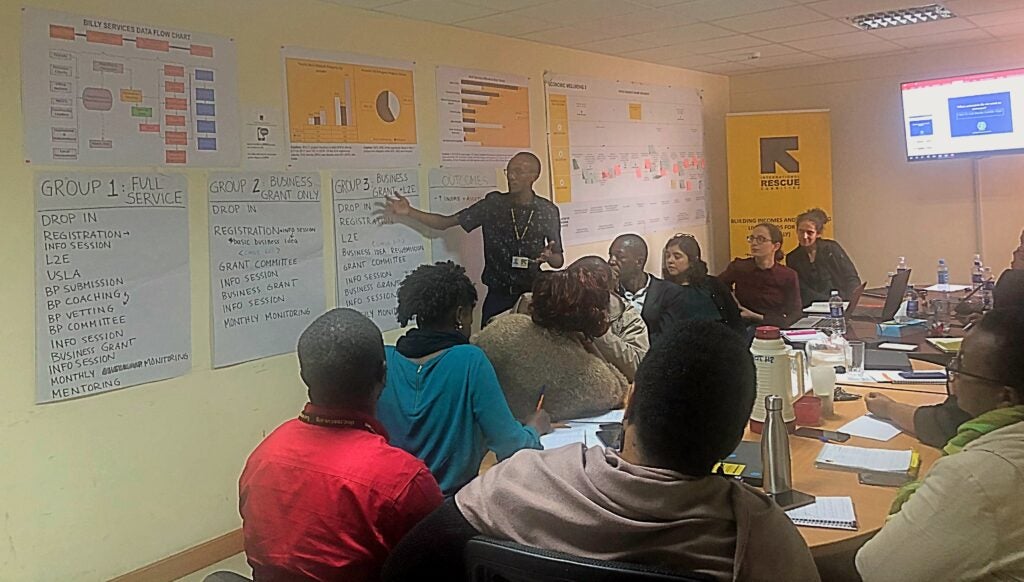The Economic Impact of COVID-19 on Refugees and Vulnerable in Nairobi, Kenya

By Giuliana Daga, Jon Helfers, Béatrice Leydier, and Alex Wendoh
Introduction
The first official case of COVID-19 was reported in Kenya in March 2020. The government subsequently took several measures to curb the spread of the virus. Some of these measures included the closing of schools and higher learning institutions, social distancing protocols in public areas, recommendations that government and business people work from home (except for essential services), prohibiting public gatherings, and a dusk to dawn curfew. This was followed by further measures including a cessation of movement in and out of the capital city (Nairobi) and making wearing of masks mandatory in all public places. While these efforts among others have arguably had a positive impact on reducing the spread of the virus, the economy has been hit hard with an estimated 1.7 million people projected to be affected in the urban informal settlements because of the pandemic. In July of 2020, gui2de-East Africa in partnership with the International Rescue Committee (IRC) conducted a phone survey to assess the effects of COVID-19 on a sample of urban refugees and vulnerable Kenyan youth who predominantly live in informal settlements. Below we provide some insights on how this population prepared for the pandemic, their coping strategies, their support systems and some policy takeaways based on their responses.
Sample and Survey
The sample is comprised of 483 respondents who are part of an ongoing study aimed at evaluating the impact of the micro enterprise track of the Building Income and Leveraging Livelihoods for Youth (BILLY) program in Kenya, a program by IRC. Respondents ages range from 18 and 35 years, 80 percent of them being urban refugees and 20 percent are Kenyans all living predominantly in the informal settlements of the capital city Nairobi. The sample is 51 percent female and 49 percent male. On economic activities, 66 percent of the respondents were either salaried, casual workers or engaged in different types of micro-enterprises and 33 percent had not been engaged in any income generating activity in the past 30 days. We surveyed the sample three times after lockdown measures: in May, in July and in October 2020.

The BILLY team designing the BILLY services received by the clients
The findings presented below focus on data from the July data collection, in order to be comparable with other study samples our teams surveyed in Kenya about COVID-19 measures around the same time, published in our other blogs on this site. Forthcoming publications will be looking in detail at the evolution over time of post-COVID outcomes for this particular population.
Findings
How did they prepare for the pandemic ?
Considering that the sample population comprises individuals that are often considered vulnerable to unforeseen risk, we were curious to understand what steps they had taken to prepare for the pandemic about 3 months after the government instituted measures to curb the effects of COVID-19 on the general population. From the sample, we find that 80 percent of the respondents bought cleaning items like soap and hand sanitizers. We also see respondents taking other measures like increasing their food purchases (23 percent), using their savings (22 percent), contacting their families for support (21 percent), borrowing money (16 percent), selling assets (10 percent) and moving to a cheaper home to cut down on expenses (3 percent). Urban to rural migration was negligible with less than 1 percent of the population moving back to their rural area or family home.
We also asked additional questions to the 10 percent of respondents who sold assets so as to get more insights on what they chose to let go and also the value of assets sold. We established that most respondents sold electronic gadgets, 26 percent being mobile phones, followed closely by radio and television sold by 12 percent of the respondents. Furniture seems to have the least amount of sales. The average amount received from the sale of assets in the previous month was Ksh. 4295.

Are they taking any precautions to avoid contracting or spreading the virus?
To understand if the population was adhering to the COVID-19 prevention protocols, we asked the respondents what actions they were taking to prevent spread of the virus or infection for the past seven days and the results show very high compliance rates. For example, 99 percent of the respondents indicated that they were washing their hands regularly with soap and water or use of hand sanitizers and also wearing a mask in public areas. The other measures taken include; covering their noses and mouth with their elbow or tissue when coughing or sneezing (78 percent), staying a distance of at least one meter from other people (71 percent), avoided touching their face (79 percent) and 68 percent reported avoiding crowded places. The high compliance rates seem unlikely to be representative of actual behaviors as they clash with our anecdotal evidence from living in Nairobi. This confirms that self-reported data for health behaviors, especially behaviors that have a social stigma associated to them, is not very reliable at face value. However, it provides insights on the relative importance of each precaution actions in our sample population: washing hands and wearing mask seems more commonly accepted than other precautionary measures.

How are respondents coping?
The direct health effects of the virus appear to be limited within the sample as none of the respondents reported to have contracted the virus themselves. We also asked a set of questions which included the ability to pay rent for the previous month, difficulties in covering expenses, food consumption and loan repayment as a way of measuring how they are coping with the pandemic. The results seem to suggest that even though the COVID-19 prevalence is low, the socioeconomic activities have significantly been impacted by the control measures.
When we asked respondents if they were able to pay their rent in the last thirty days, 56 percent of the respondents said that they had not paid anything, 13 percent said they had made partial payment and only 29 percent said they had paid their rent in full. Additionally, 93 percent said they had encountered more difficulties than usual in covering their expenses with 85 percent saying they either had to skip a meal or reduce their food consumption.
For those with outstanding loans, 29 percent said they have had to defer or decrease their installments due to the COVID-19 effect on their income generating activities. Furthermore, 27 percent said they had taken new loans within the previous month with a majority (62 percent) using all the money for subsistence needs. Only 11 percent of the respondents reported to have used the loans purely for business purposes.
Did they get any support – in cash or kind?
The COVID-19 pandemic has forced a majority of people to stay or work from home and practice social distancing resulting to increased job losses, reduced income and increased food prices especially in urban areas. This is according to the United Nations Office for the Coordination of Humanitarian Affairs (OCHA) situation report. Our assumption therefore is that the vulnerable populations would have been supported to protect themselves against the virus and at least have the basics to survive these hard times.
Overall, 32 percent of the respondents reported to have received some form of assistance either in cash or in kind from other sources. Our data however seems to suggest that the government either did very little to support the population’s social welfare or that these efforts haven’t been noticed by respondents. This is informed by the fact that less than 2 percent of the respondents reported to have received assistance (in cash or in kind) from either the national or county government. Of those who reported having received support, 66 percent of respondents said it was from family and friends, followed by religious organizations at 17 percent. Private individuals/ organizations and NGO’s are at 13 percent and 12 percent respectively. A majority of those who received assistance said it was in form of food followed closely by cash.
Policy Takeaways
The sample population took some actions to prepare for the pandemic. In particular, respondents reported stocking cleaning materials. What is less clear is if respondents could not afford or did not deem necessary taking other precautionary measures such as stocking food supplies. The findings also suggest that this population is vulnerable to the economic effects of government measures to contain the pandemic. Nearly 56 percent reported not paying rent within the last 30 days and 9 out of 10 respondents reported they had difficulty covering their expenses as well as the same proportion stating that they had skipped a meal or reduced consumption. This is compounded by the fact most nearly 68 percent reported having received no support to offset the impact of COVID-19 on their household. Of those who had received support only 5 percent recorded support from NGO’s or the government. We would suggest more direct support not only from the government agencies but also NGOs. Direct cash assistance may be a more targeted way to directly help this vulnerable population and address the immediate economic concerns such as reduction in food consumption and not being able to pay rent.
The government has taken several measures to cushion the vulnerable population including a reduction in VAT from 16 percent to 14 percent, a temporary suspension of listing with Credit Reference Bureaus (CRB) for loan defaulters and offering 100 percent tax relief for those earning a gross of less than Ksh. 24,000. An additional Ksh. 10 billion was also offered to support the elderly, orphans and other vulnerable populations through cash transfers. It is unclear if these measures have simply not been noticed by respondents of this survey or if these measures are poorly targeted to the needs of this population. This suggests that there’s still significant room for the government to work more closely with the non-governmental organizations and donor communities to improve targeting of vulnerable populations to ensure funds reach the designated beneficiaries.
Since this survey the government has taken some more steps to lessen the economic fallout from its initial measures by revoking the cessation of movement it had place in and out of Nairobi and adjusting the curfew from dusk to 11pm and now 9pm. This suggests that policy makers are cognizant of the economic effects of their actions but continue to try and balance economic and health concerns. We would recommend that the government continues to do this and put greater emphasis on prevention measures such as wearing of masks, hand washing, and limiting social gatherings but encouraging a resumption of economic activity where possible.




